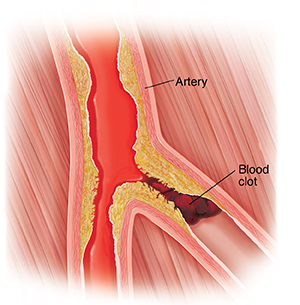Peripheral Arterial Thrombolysis
Peripheral arterial thrombolysis is a procedure to dissolve a blood clot in a leg or arm artery. It brings blood flow back to your leg or arm. If a blood clot forms in an artery in your leg or arm, blood flow to that limb can be blocked. This can cause severe pain and tissue death in your limb. Peripheral arterial thrombolysis is often done by an interventional radiologist. This is a healthcare provider who is specially trained and certified by the American Board of Radiology to use minimally invasive image-guided procedures to diagnose and treat diseases. This may also be done by a vascular surgeon.

Getting ready for your procedure
Tell your healthcare provider if you are:
Tell your healthcare provider about:
You may need to stop taking all or some of these before the test. This includes:
-
All prescription medicines
-
Herbs, vitamins, and other supplements
-
Over-the-counter medicines, such as aspirin or ibuprofen
-
Illegal drugs
Follow any directions you’re given for not eating or drinking before the procedure. Follow any other directions from your healthcare provider.
During your procedure
In general, you can expect the following:
-
An IV (intravenous) line is put into a vein in your hand or arm. This is to give you fluid and medicines. You may be given medicine through the IV to help you relax (sedation). Medicine will be put into your skin where the procedure will be done. This will keep you from feeling pain at the insertion site.
-
A very small cut (incision) is made at the insertion site. A thin, flexible tube (catheter) is put through the incision into your artery. The healthcare provider watches the catheter’s movement on a screen.
-
X-ray dye is injected through the catheter into your artery. This helps the artery be seen clearly on X-ray images. The healthcare provider uses these images as a guide. They move the catheter to the clot.
-
When the catheter reaches the clot, the healthcare provider injects medicine into the catheter. The medicine will dissolve the clot. This is done slowly, over a few hours. The catheter is left in place until the clot has dissolved. This can take up to 72 hours.
-
Once the clot has dissolved, you may need to have your artery widened. This will be done using a medical balloon (peripheral angioplasty). A mesh tube (stent) may also be used to keep the artery from narrowing.
-
When the procedure is finished, the catheter is taken out. Pressure is put on the insertion site for 15 minutes to stop bleeding.
After your procedure
-
Your healthcare provider will tell you how long you must lie down and keep the insertion site still.
-
You may stay in the hospital overnight.
-
You may have some pain. This can be controlled with medicine.
-
Drink plenty of fluids to help flush the X-ray dye out of your body.
-
After you go home, care for the insertion site as directed.
-
Tell your healthcare provider if you develop a fever or the chills.
Possible risks
All procedures have some risk. Possible risks of peripheral arterial thrombolysis include:
-
Bleeding at the insertion site or inside your body
-
Bruising at the insertion site
-
Damage to your artery
-
Problems because of X-ray dye, including allergic reaction or kidney damage
Online Medical Reviewer:
Neil Grossman MD
Online Medical Reviewer:
Rita Sather RN
Online Medical Reviewer:
Tara Novick BSN MSN
Date Last Reviewed:
12/1/2022
© 2000-2025 The StayWell Company, LLC. All rights reserved. This information is not intended as a substitute for professional medical care. Always follow your healthcare professional's instructions.